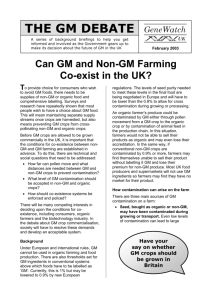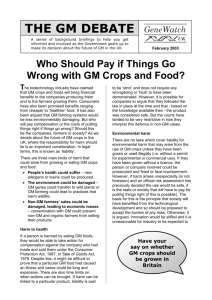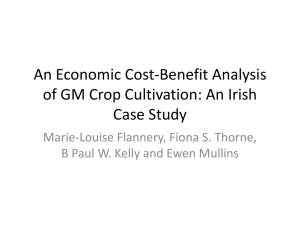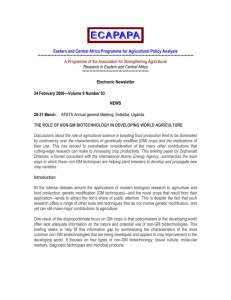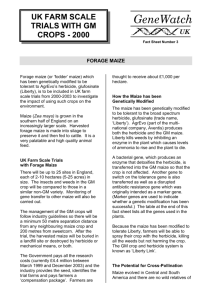Stratégies de collecte dans les filières de maïs OGM et non
advertisement
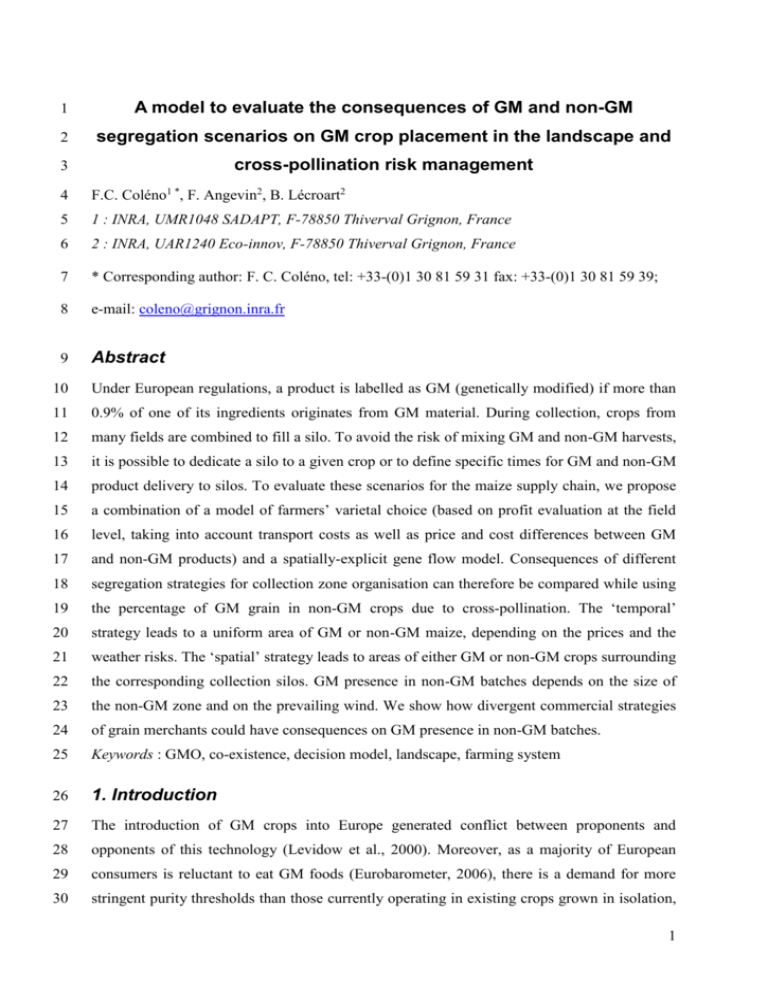
1 A model to evaluate the consequences of GM and non-GM 2 segregation scenarios on GM crop placement in the landscape and 3 cross-pollination risk management 4 F.C. Coléno1 *, F. Angevin2, B. Lécroart2 5 1 : INRA, UMR1048 SADAPT, F-78850 Thiverval Grignon, France 6 2 : INRA, UAR1240 Eco-innov, F-78850 Thiverval Grignon, France 7 * Corresponding author: F. C. Coléno, tel: +33-(0)1 30 81 59 31 fax: +33-(0)1 30 81 59 39; 8 e-mail: coleno@grignon.inra.fr 9 Abstract 10 Under European regulations, a product is labelled as GM (genetically modified) if more than 11 0.9% of one of its ingredients originates from GM material. During collection, crops from 12 many fields are combined to fill a silo. To avoid the risk of mixing GM and non-GM harvests, 13 it is possible to dedicate a silo to a given crop or to define specific times for GM and non-GM 14 product delivery to silos. To evaluate these scenarios for the maize supply chain, we propose 15 a combination of a model of farmers’ varietal choice (based on profit evaluation at the field 16 level, taking into account transport costs as well as price and cost differences between GM 17 and non-GM products) and a spatially-explicit gene flow model. Consequences of different 18 segregation strategies for collection zone organisation can therefore be compared while using 19 the percentage of GM grain in non-GM crops due to cross-pollination. The ‘temporal’ 20 strategy leads to a uniform area of GM or non-GM maize, depending on the prices and the 21 weather risks. The ‘spatial’ strategy leads to areas of either GM or non-GM crops surrounding 22 the corresponding collection silos. GM presence in non-GM batches depends on the size of 23 the non-GM zone and on the prevailing wind. We show how divergent commercial strategies 24 of grain merchants could have consequences on GM presence in non-GM batches. 25 Keywords : GMO, co-existence, decision model, landscape, farming system 26 1. Introduction 27 The introduction of GM crops into Europe generated conflict between proponents and 28 opponents of this technology (Levidow et al., 2000). Moreover, as a majority of European 29 consumers is reluctant to eat GM foods (Eurobarometer, 2006), there is a demand for more 30 stringent purity thresholds than those currently operating in existing crops grown in isolation, 1 31 such as waxy maize or high erucic rapeseed. To satisfy this demand, while allowing farmers 32 to make a practical choice between conventional, organic, and GM crop production, the 33 European Commission has proposed several recommendations for ensuring coexistence at the 34 field scale (EC, 2003a) and promulgated regulations controlling segregation of GM and non- 35 GM products “from farm to fork” (EC, 2003b and c). 36 Within the food-processing industry, traceability of GM products has to be implemented 37 throughout the whole supply chain. Indeed, positive labelling is compulsory when a product 38 contains more than 0.9% of GM material per ingredient (EC, 2003c). In order to avoid such a 39 positive labelling, PCR tests (Lüthy, 1999) can be used to assess the presence of GM material 40 when DNA is present in the product. Moreover, the food industry uses risk management 41 methods to identify critical points and to propose quality control methods such as the Hazard 42 Analysis Critical Control Point (HACCP) method (Scipioni et al., 2005). As a consequence of 43 potential cumulative risks in the food chain and to guarantee a level lower than 0.9% of GM 44 material in non-GM products, a 0.1% maximum level of GM presence is required by the 45 industry for non-GM batches delivered by farmers and grain merchants (Raveneau, 2005). 46 In this paper, we consider the consequences of the introduction of Bt maize (resistant to corn 47 stalk borer) into European cropping systems. Indeed, Bt maize is the only GM crop grown 48 commercially in the EU, mainly in Spain, where 60,000 hectares of it were grown in 2006 49 (James, 2006). 50 In the field, adventitious presence of GM material can have several sources: pollen flow, 51 impurities in seed lots, and volunteer plants (Colbach et al., 2001). Due to the cold winter 52 climate as well as ploughing in the majority of cropping systems including maize, this latter 53 source can be considered negligible (Angevin et al., 2008). According to European 54 recommendations (EC, 2003a), a farmer using GM seed has to use technical measures to 55 avoid adventitious presence in the neighbouring non-GM fields, such as ensuring isolation 56 distances and flowering time-lags (Beckmann et al., 2006), whose efficiency in decreasing 57 cross-pollination risk is known (Halsey et al., 2005). 58 At the farm scale, the use of the same agricultural machinery (such as a seed drill or 59 harvester) for both GM and conventional production increases the risk of admixture (Jank et 60 al., 2006; Messéan et al., 2006). For grain merchants, the problem is to ensure segregation of 61 the two products in their supply chain and, as far as possible, to manage cross-pollination risk 62 between GM and non-GM fields in their collecting area. 63 Several European studies on segregation made in collaboration with grain merchants resulted 64 in the identification of two possible management strategies (Miraglia et al., 2004): 2 65 A ‘temporal strategy’ where the two products are separated by the timing of the 66 collection period. In this case, each product is delivered to the collection silo nearest to 67 the farm, but within a given period. It is therefore not necessary to manage product 68 separation in collection silos. Besides, by concentrating the collection of a product 69 over a short period of time it is possible to have a sufficient flow of material to be able 70 to dedicate a drying line to this product and to fill one or more storage bins. The 71 inconvenience of this strategy for the grain merchant is that farmers can choose to 72 deliver to a more flexible competitor when they want to harvest. This leads to a loss of 73 volume collected and thus a loss of market share. 74 A ‘spatial strategy’ based on a geographic grouping decided before sowing. Each 75 collection silo and accompanying dryer(s) receives only one type of product, thereby 76 defining an independent supply chain for each product. The risk of mixing between 77 GM and non-GM products is therefore controlled. Moreover, farmers are informed 78 about this allocation before sowing, so they can choose their crop type taking into 79 account the product accepted by the nearest collection silo and the cost of 80 transportation to other collection silos. This strategy indirectly encourages farmers to 81 choose a particular crop type, but it does not protect grain merchants from farmers that 82 deliver to a competitor closer to their farm who would accept both products. 83 Both of these strategies have implications for the allocation of GM and non-GM varieties over 84 the agricultural landscape. While the second allows a homogeneous zone of each cultivar 85 around silos, the first lets farmers choose their varieties. 86 Such strategies have not been developed in Europe, and specifically in France, because of the 87 small GM maize area sown (James et al., 2006). In this paper, we evaluate the efficiency of 88 these strategies to minimize cross-pollination of non-GM by GM crops. Such an evaluation is 89 necessary to elaborate co-existence scenarios at the scale of the collection zone. We used a 90 modelling approach by combining a model of farmer’s choice between GM and non-GM 91 varieties for each field in a zone (Coléno, 2008a) with a spatially-explicit model of gene flow, 92 MAPOD® (Angevin et al, 2008). 93 2. Methods 94 2.1. The farmer’s choice model 95 The model used is based on maximisation of the farmer’s profit at the field level (Coléno, 96 2008a). To calculate this profit, we took into account the yield (Y); the product price (P); a 3 97 potential quality loss (L) which is an estimate of the decrease in product quality, when the 98 farmer is compelled to delay harvesting because of collection firm constraints; the seed costs 99 (Cs); the pesticide costs (Cp) linked to the nature of the GM variety; the transportation costs 100 (Ctr); and the distance of the field from the silo where the product is accepted (d). 101 Thus, we have: 102 ProfitGM = YGM*PGM *LGM - Cs - Ctr*d (1) 103 ProfitnonGM = YnonGM*PnonGM *LnonGM - Cs - Cp - Ctr*d (2) 104 In the case of spatial separation, L is equal to 0. Farmers can deliver their crop whenever they 105 want to the silo dedicated to the appropriate crop. 106 2.2. The MAPOD® model 107 In the case of maize, gene flow is mainly due to intra-specific cross-pollination in crop and 108 seed production fields. Indeed, under normal European conditions, because of the cold winter 109 climate as well as ploughing in the majority of cropping systems including maize, volunteer 110 plants from previous maize crops are rare and may be controlled easily by agricultural 111 techniques. 112 MAPOD® is a spatially-explicit model that estimates the percentage of varietal impurities 113 due to cross-pollination in maize as well as changes in these percentages due to modifications 114 in cropping techniques (Angevin et al., 2008). It consists of two modules. 115 The first module determines the flowering date for female flowers, expressed in degree-days, 116 as a function of climate and sowing date (Durand, 1969; Derieux and Bonhomme, 1982, 117 1990). Most of the varieties currently used display protandry, which means that male 118 flowering begins several days before female flowering. The duration (in days) of this time lag 119 can be used to calculate the flowering time for male flowers. Drought stress and sowing 120 density affect protandry. Modelling the dynamics of male and female flowering then makes it 121 possible to estimate the amounts of pollen produced by GM and non-GM varieties and the 122 number of receptive silks for non-GM maize varieties. Factors affecting the viability of pollen 123 and the receptivity of silks are taken into account. The composition of the pollen cloud in the 124 air around the plants is therefore known on a day-to-day basis for the entire flowering period. 125 Pollen dispersal is simulated in the second module by a Normal Inverse Gaussian function 126 (NIG; Klein et al., 2003). It is a function of distance from the emitter, and its parameters are 127 the direction and mean speed of the wind during the course of flowering and the difference in 128 height between the panicle from which the pollen is emitted and the receptive silks. The 4 129 composition of the pollen cloud at a given site in a non-GM field is determined by the pollen 130 dispersal curves for all the plants in the neighbourhood, whether close by or further away. 131 Each day, the frequency of GM seeds is calculated as the ratio of the number of non-GM 132 ovules fertilised by GM pollen to the total number of ovules fertilised. These daily results are 133 pooled to provide the extent of GM impurities in the non-GM crop. 134 The input variables for MAPOD® include certain traits of the varieties and certain 135 agricultural practices for each maize field as well as climatic factors for the region studied 136 (Table 1). The output is the percentage of GM impurities in the non-GM harvest on the scale 137 of a field, a group of fields, or a collection area. This model has been used to carry out several 138 co-existence studies (Angevin et al., 2002; Messéan et al., 2006). 139 The preliminary evaluation of MAPOD® was carried out by comparing simulation results 140 with data from two French and one American gene flow field trials. MAPOD® was found to 141 provide good average predictive values (Angevin et al., 2008). An indirect evaluation was 142 also performed by simulating the French seed production rules with the model. These 143 simulation results are consistent with the rates of impurities measured in commercial seed 144 lots. The effect of sowing male sterile maize rows to diminish risks of cross-pollination, 145 which was empirically tested as efficient by seed growers, appears to be correctly simulated 146 (See Messéan et al., 2006, for details). Further evaluation of the overall predictive quality of 147 the model is on-going in the case of several real agricultural contexts of GM commercial 148 releases in Spain. 149 2.3. Input data and work assumption 150 The farmer’s choice model was used on a 100 km2 area (Figure 1), assuming that a field 151 would be sown with GM maize if this were be more profitable than a non-GM variety. All the 152 agricultural area was sown with maize. Four silos are located in this area. 153 We simulated both separation strategies, assuming that one firm owns silos 1, 2 and 3, and 154 another owns silo 4. For the spatial strategy, silo 3 is dedicated to non-GM harvests and the 155 competing firm would accept all products, whether GM or not, at the same price. 156 Table 2 shows the values used for the calculation of profit in the farmer’s choice models. We 157 choose a 7% difference in price between GM and non-GM products. This difference allows 158 there to be a partition between GM and non-GM production. Using a higher or a lower price 159 difference would lead to a homogeneous landscape. As shown in Figure 2, the effect of a 160 price difference is very large, and all farmers can change their choice quickly depending on 161 price changes (Coléno, 2008a). 5 162 For the temporal strategy we tested two assumptions: in one case, the GM crop is collected 163 when maize quality is at its optimum (LGM = 0), and in the other, we assumed that non-GM 164 production is collected when maize quality is optimal (LnonGM=0). The simulation was carried 165 out with a loss of quality causing a 10% fall in price, which is consistent with the actions of 166 grain merchants (Raveneau, 2005). 167 With this model, on the level of an agricultural landscape, we can show the type of variety 168 (GM or non-GM) chosen for every field. The field allocation obtained is one of the input 169 variables of the MAPOD® model (Table 1). To run simulations calculating cross-pollination 170 between fields we assume that non-GM seeds do not contain GM impurities, that GM and 171 non-GM cultivars have similar morphological and phenological characteristics (a risky 172 situation), and that crop management is the same for both cultivars. We tested three types of 173 wind: a north wind, a west wind, and the wind distribution obtained from the meteorological 174 station located at Colmar (48°05’ N 7°21’E), which is shown in Figure 3. 175 Finally, to properly evaluate the efficiency of the various collection strategies on GM 176 impurity rates in non-GM silos, we have simulated one more situation in which the farmers 177 freely choose the type of variety they will sow (‘case with no collection strategy’). We 178 represented this situation by a random allocation of both varieties in the agricultural 179 landscape. We assumed a proportion of 60 % of GM maize in the total cultivated area, which 180 is equivalent to the GM proportion in the spatial strategy with one grain merchant, with the 181 values of the variables defined above. 182 3. Results 183 3.1. Case with no collection strategy 184 The first line of Table 3 presents the weighted mean of GM impurity levels in non-GM 185 batches due to cross-pollination for ten random distributions of GM crops in the zone. In all 186 cases, the maize collection did not comply with the 0.9% legal threshold, so it would not have 187 been possible to sell this maize to the non-GM market. 188 In view of our working assumptions and the features of the landscape studied (a fairly 189 uniform field size), we can see that the GM and non-GM field arrangement has little influence 190 on the GM percentage in non-GM batches. This is shown by the small difference in the 191 percentage of GM caused by wind direction, as well as by the small standard deviations 192 between the distributions of GM and non-GM allocations. For a given wind, the variability in 193 the mean accidental GM presence in the non-GM batches is quite low. On the other hand, the 6 194 proportion of the non-GM area that is not compliant with the 0.9% threshold varies between 195 62% and 77% among the 10 crop allocations to fields and the three wind distributions. 196 3.2. Temporal strategy 197 Figure 4 presents the distribution of GM and non-GM crops in the collection area when the 198 temporal strategy is implemented. In this case, GM batches are collected at the beginning of 199 the harvesting period, before the non-GM ones, in order to avoid admixture within silos and 200 dryers. We find a homogeneous distribution of the variety when this collection strategy is 201 used. Farmers’ incomes are linked to the probability that the optimal maize harvest date is the 202 period of collection for his crop. This probability depends on the period of the collection 203 period. If the GM maize collection period is shorter than the non-GM one, the income of 204 farmers growing GM cultivars is lower. As a result, farmers could therefore choose to only 205 sow non-GM varieties (Figure 4a). The opposite situation is shown in figure 4b. 206 3.3. Spatial strategy with one grain merchant 207 We have assumed in this case that there is only one grain merchant in the territory, owning 208 silos 1, 2 and 3 (Figure 1). The distribution of GM and non-GM varieties obtained by using 209 the farmer’s choice model is presented in Figure 5. The non-GM crops surround silo 3, which 210 is dedicated to them, while GM crops are located around silos 1 and 2. The size of the non- 211 GM area can be modified according to the price difference between GM and non-GM maize 212 paid by the grain merchant. 213 The second line of Table 3 shows the percentage of GM grain in the non-GM silo as affected 214 by wind direction. In each case, this percentage is relatively low and below the 0.9 % 215 threshold. It is thus possible to sell the collected batches on the non-GM market. Besides, this 216 percentage depends on the wind distribution and is higher with a northerly wind. Indeed, in 217 this case, the wind is blowing from the GM maize area to the non-GM maize area, which is 218 the worst case. There are two main prevailing winds (north and south) in the Colmar region. 219 A south wind is the more favourable, because the non-GM fields are upwind. That is why the 220 cross-pollination rate is lower and closer to 0.1% with the real wind distribution. Taking into 221 account the most unfavourable wind direction may lead to an overestimate of the risk of GM 222 admixture due to pollen flow. Grain merchants should thus consider the real wind 223 distribution. 224 If we compare the first and second lines of Table 3, we notice a large decrease in GM grain 225 percentage in the non-GM silo. Therefore, the organization of production in the collection 7 226 zone can reduce the cross-pollination risk not by using isolation distances between GM and 227 non-GM fields but by indirectly creating field clusters such as those that exist for specific 228 maize crops such as waxy maize (Meynard and Le Bail, 2001). In this case, the core of the 229 non-GM zone is isolated from GM sources while harvests of ‘frontier’ fields containing GM 230 impurities could be diluted by mixing in the silo, or they could be collected separately. 231 3.4. Spatial strategy with two grain merchants 232 In this case, two grain merchants share the harvest collection within the study zone. The first 233 merchant owns silos 1, 2, and 3, and collects GM maize in silos 1 and 2 and non-GM maize in 234 silo 3. The second owns silo 4 and has a different commercial policy. GM and non-GM 235 harvests are collected in the same silo and the company pays the same price for both products. 236 Figure 6 shows the distribution of GM and non-GM varieties in the agricultural landscape 237 resulting from these two competing commercial policies. We see that the second firm’s 238 strategy leads to the creation of a GM zone around silo 4, inducing a decrease in the non-GM 239 area to 30% of the total area grown. 240 The third line of Table 3 shows the percentage of GM adventitious presence in the non-GM 241 silo simulated by MAPOD®. Although GM production has increased in the zone, the 242 percentage of GM grain in the non-GM batches remains low on average and below 0.9%. It is 243 therefore possible to sell the collected crops to the non-GM market. If we compare the second 244 and the third line of Table 3, we see that the GM percentage remains relatively low. It is thus 245 possible to limit the proportion of GM in the non-GM silo by organising production in the 246 zone, even if it contains a high proportion of GM maize. 247 However, if we compare the second and the third line of Table 3 we see that the amount of 248 GM adventitious presence is three times as great in the case of a westerly prevailing wind 249 blowing from the GM area (Figure 6). This percentage still complies with the 0.9 % threshold. 250 However, the presence of several competitors in the same zone with different commercial 251 policies can lead to an increase in GM impurity rates in the non-GM silo. Due to the stringent 252 requirements of the maize food chain (Raveneau, 2005), this could lead to the loss of potential 253 outlets for this crop. 254 3.5. Impact of farmers’ behaviour on non-GM silo purity 255 Table 4 shows the percentage of the non-GM area cultivated in GM necessary to contaminate 256 the non-GM silo to an extent which would deny access to the non-GM market. It also shows 257 that a very small area sown with GM in the non-GM zone (from 0.36 to 0.73%) would result 8 258 in exclusion from the non-GM market. To prevent such a situation, companies would have to 259 adopt several strategies, such as crop contracts with farmers and information management 260 about farmers’ practices. Such a policy would increase the transaction costs associated with 261 co-existence. 262 4. Discussion 263 4.1. Limitations of the farmer’s choice model 264 The model of crop allocation that we have used in this study is based on the maximisation of 265 profit for each field. It has two assumptions that warrant discussion. 266 The first is that the risk covered by the use of GM maize is uniform over the collection zone. 267 In fact, the distribution of the agronomic risk due to the corn borer is not uniform throughout 268 any area, so the farmer’s choice between GM and non-GM maize should be linked to this 269 constraint (Bourguet et al., 2005). The use of agronomic variables in the model of farmers’ 270 choices might put into perspective the results presented here, because they would apply to 271 larger and more representative geographical zones of the whole collection region of a grain 272 merchant. Taking into account these agronomic factors and a larger area would allow one to 273 search for alternative collection strategies. A spatial strategy with different delivery periods 274 for each product could be considered. It would then be possible to take into account different 275 flowering times to avoid field-to-field cross-pollination (Halsey et al., 2005; Messéan et al., 276 2006). 277 The second is that the optimal period for maize harvesting can be relatively short. The 278 probability of being able to harvest during this period is connected to the total duration of 279 collection. Such an assumption must be put into perspective. It applies in northern Europe and 280 in Alsace in particular (Raveneau, 2005). In southern Europe (southwest France or Spain), the 281 climate is more favourable and the optimal period for maize harvesting lasts longer. It is 282 therefore possible to consider temporal strategies of collection that have a lower collection 283 cost (Coléno, 2008b). In this case, farmers would support cross-pollination risk management, 284 possibly growing GM varieties so as to set up isolation distances or non–GM buffer zones 285 around their fields to avoid the risks of cross-pollination (EC, 2003a). 286 4.2. Effect of the strategies studied on GM crop planting 287 Introduction of GM varieties on a landscape scale comes up against regulations based mainly 288 on the use of isolation distances (Beckmann et al., 2006), whatever the characteristics of the 9 289 agricultural landscape. In regions where fields are small and fragmented, GM maize can only 290 be sown in a small number of fields (Devos et al., 2007). Furthermore, when fields are small, 291 with scattered ownership, non-GM production can lead to prohibition of GM production on 292 almost all the land because of a domino effect (Demont et al., 2008). But this domino effect 293 could lead to an exclusion of organic farming in the landscape, because of a greater isolation 294 distance between GM and organic fields. 295 All this takes only account of farmers’ choices at an individual level, and so leads to solution 296 for co-existence at the field level. Taking into account grain merchants’ strategies allows GM 297 and non-GM co-existence to be considered at the landscape level. It is thus possible to take 298 into account incentive mechanisms with farmers (contract or price setting) in order to 299 organise GM and non-GM production at a higher level than that of the field. Hence it is 300 possible to bypass the problem of isolation distances between GM and conventional fields by 301 concentrating non-GM production in specific zones. Co-existence of both crops in the zone 302 may then be possible. 303 4.3. How should the boundaries of the collection zone be managed? 304 The definition of homogeneous zones, such as are used for waxy maize production in certain 305 regions (Meynard and Le Bail, 2001), raises the question of boundary management. Indeed, 306 we calculated the adventitious presence of GM material for the whole non-GM maize area. 307 This average percentage masks the disparities between fields in the core of the non-GM zone 308 and those located near the boundaries. 309 In the case of maize, the quantity of dispersed pollen diminishes with distance (Bateman, 310 1947a; b; Raynor et al., 1972). Non-GM fields in the border zone are closer to the GM pollen- 311 emitting source than those in the core, and consequently have a higher GM rate than the 312 average (results not shown). 313 The management of these fields thus requires: 314 limiting the rate of cross-pollination by implementing co-existence measures such 315 as isolation distances (Jones and Brookes, 1950), time-lag of flowering (Halsey et 316 al., 2005), or non-GM buffer zones (Messéan et al., 2006); 317 setting up compensation mechanisms for non-GM crops that would have to be sold 318 as GM. Such mechanisms can be implemented either via producers' clubs (Furtan 319 et al., 2007) or they may be provided by grain merchants in order to ensure a low 320 GM rate in the core of the non-GM zone. 10 321 4.4. How to deal with grain merchants with divergent strategies? 322 Use of appropriate collection strategies realise on the creation of a non-GM production zone 323 of sufficient size to guarantee a low percentage of GM in non-GM batches. A decrease in the 324 size of the non-GM zone, because of competitors with different commercial strategies, causes 325 an increase in the GM percentage in non-GM batches. Consequently, the non-GM zone 326 should be located in areas where the competition between grain merchants is low. Another 327 possibility is that grain merchants coordinate GM and non-GM variety allocation in the zone. 328 This leads to the development of co-opetition strategies (Nalebuff and Brandenburger, 2002) 329 at the scale of the collection zone. Therefore, GM and non-GM crop co-existence could lead 330 to new collective strategies of the various firms involved in the supply chain, between clients 331 and suppliers as well as between competitors. 332 5. Conclusion 333 To overcome difficulties in the segregation of GM and non-GM crops in the supply chain, it 334 is necessary to dedicate silos and dryers to either crop over the course of time or by defining 335 GM and non-GM zones in the agricultural landscape and collection infrastructure. 336 These two basic solutions lead to an increase in collection costs due to an increase in transport 337 costs and a decrease in the flexibility of the collection process (Bullock and Desquilbet, 2002; 338 Coléno, 2008b). Moreover, these strategies do not have the same effect on landscape 339 organization and on the risk of cross-pollination between GM and non-GM fields. The spatial 340 strategy could allocate parts of the landscape to each crop and thus minimize accidental GM 341 presence. The temporal strategy would lead to uniform GM and non-GM zones while only 342 considering the farmer’s economic benefit. In this case, there is no risk of cross-pollination. 343 But, from an agronomic point of view in relation to the different exposures to risk concerning 344 Bt maize, it is possible that the spatial allocation of GM and non-GM crops would no longer 345 be homogeneous. In such a case, considering European regulations, GM production might 346 have to be reduced because of the impossibility of producing a GM crop close to non-GM 347 fields of the same species (Demont et al., 2008; Devos et al., 2007). 348 Moreover, in order to go further to evaluate collection strategies at the landscape level it id 349 necessary to improve the two models used there. Concerning the farmer’s choice model, it 350 would be possible to develop a multi-criterion model of farmer’s choice that takes into 351 account economic and agronomic factors. For MAPOD®, the specific effect of canopy 352 discontinuities (such as other crops, hedges or roads) on pollination patterns at field edges 353 needs to be better modelled. 11 354 Considering the difficulties of segregation management, it seems necessary to consider 355 landscape governance (Byrne and Fromherz, 2003) in order to define an optimal collection 356 strategy for grain merchants that takes into account the cost management of segregation in the 357 supply chain as well as the costs of managing GM crop distribution in the agricultural 358 landscape. Specifically, it seems necessary to evaluate the feasibility of cooperation between 359 different grain merchant companies in order to manage the collection zone. 360 Acknowledgments 361 Original maps were provided by the Institute for the Protection and Security of the Citizen 362 (Joint Research Centre of the European Union) and AUP-ONIGC - ex ONIC (Office National 363 Interprofessionnel des Céréales). We thank Ms Tanis-Plant for editorial advice in english and 364 K. Adamczyk for her technical help. 365 Funding for this research was provided by the French Ministry of Research through the 366 national program “ACI OGM et environnement” and by the European commission through 367 the Sixth Framework Program, integrated project Co-Extra (contract Food-2005-CT-007158). 368 References 369 Angevin, F., Colbach N., Meynard, J.M., Roturier, C., 2002. Analysis of necessary 370 adjustements of farming practices, In A.-K. Bock, Lheureux, K., Libeau-Dulos, M., Nilsagard 371 H., Rodriguez-Cerezo, E., eds. Scenarios for co-existence of genetically modified, 372 conventional and organic crops in European agriculture. Technical Report Series of the Joint 373 Research Center of the European Commission. EUR 20394 EN 374 Angevin, F., Klein, E.K., Choimet, C., Gauffreteau, A., Lavigne, C., Messéan, A., Meynard, 375 J.M., 2008. Modelling impacts of cropping systems and climate on maize cross-pollination in 376 agricultural landscapes: The MAPOD model., European journal of Agronomy. 28, 471-484 377 Bateman, A. J., 1947a. Contamination in seed crops I: Insect pollination. J. Genet. 48, 257- 378 275. 379 Bateman, A. J., 1947b. Contamination in seed crops II: wind pollination. Heredity. I, 235-246. 380 Beckmann, V., Soregaroli, C., Wesseler, J., 2006. Coexistence rules and regulations in the 381 European Union. American Journal of Agricultural Economics. 88, 1193-1199. 382 Betbesé, I., Lucas J.A., 2006. Varietats de panís, Dossier tècnic, Ruralcat. 24p 383 Bourguet, B., Desquilbet, M., Lemarié, S., 2005. Regulating insect resistance management: 384 the case of non-Bt corn refuges in the US. Journal of Environmental Management. 76, 210- 385 220. 12 386 Brookes, G., 2002. The farm level impact of using Bt maize in Spain. PGEecnomics, 23p. 387 http://www.pgeconomics.co.uk/pdf/bt_maize_in_spain.pdf 388 Bullock, D.S., Desquilbet, M., 2002. The economics of non-GMO segregation and identity 389 preservation. Food Policy 27, 81-99. 390 Byrne, P. F., Fromherz, S., 2003 Can GM and Non-GM Crops Coexist? Setting a Precedent in 391 Boulder County, Colorado, USA, Journal of Food, Agriculture & Environment 1, 258-261. 392 Colbach, N., Clermont-Dauphin, C., Meynard, J. M., 2001. GENESYS: a model of the 393 influence of cropping system on gene escape from herbicide tolerant rapeseed crops to rape 394 volunteers. II. Genetic exchanges among volunteer and cropped populations in a small region. 395 Agric. Ecosyst. Environ. 83, 255-270. 396 Coléno, F.C., 2008a. A simulation model to evaluate the consequences of GM and non-GM 397 segregation rules on landscape organization. Journal of International Farm management. 4-3 398 (www.ifmaonline.org/pdf/journals/Vol4_Ed3_Coleno.pdf) 399 Coléno, F.C., 2008b. Simulation and evaluation of GM and non-GM segregation management 400 strategies among European grain merchants. Journal of Food Engineering. 88; 306-314 401 Comité National du Transport. 2006. Simulateur de prix de revient transport régionaux 402 (www.cnt.fr). 403 Demont, M., Daems, W., Dillen, K., Mathijs, E., Sausse, C., Tollens, E., 2008. Regulating 404 coexistence in Europe: Beware of the domino-effect!. Ecological Economics, 64, 683-689. 405 Derieux, M., Bonhomme, R. 1982. Heat unit requirements for maize hybrids in Europe. 406 Results of the European FAO sub-network. I. Sowing-silking period. Maydica. 27, 59-77. 407 Derieux, M., Bonhomme, R. 1990. Heat units requirements of maize inbred lines for pollen 408 shedding and silking: results of the European FAO network. Maydica. 35, 41-46. 409 Devos, Y., Reheul, D., Thas, O., De Clercq, E. M., Cougnon, M., Cordemans, K., 2007. 410 Implementing isolation perimeters around genetically modified maize fields. Agronomy For 411 Sustainable Development, 27, 155-165. 412 Durand, R. 1969. Signification et portée des sommes de températures. Bull. tech. inf. 238, 413 185-190. 414 Eurobarometer. 2006. Europeans and biotechnology in 2005: Patterns and trends. European 415 Commission's Directorate General for Research, Eurobarometer 64.3, 85 p. 416 European Commission. 2003a. Commission recommendations of 23 July 2003 on guidelines 417 for the development of national strategies and best practices to ensure the co-existence of 418 genetically modified crops with conventional and organic farming, 2003/556/EC (notified 13 419 under document number C(2003) 2624), , pp. pp 36-47. Official Journal of the European 420 Union, 29/07/2003, vol. 46, L189. 421 European Commission. 2003b. Regulation (EC) N° 1829 / 2003 of the European Parliament 422 and of the Council of 22 September 2003 on genetically food and feed, pp. pp1–23. Official 423 Journal of the European Union,18/10/2003, vol. 46, L268. 424 European Commission. 2003c. Regulation (EC) N° 1830 / 2003 of the European Parliament 425 and of the Council of 22 September 03 concerning the traceability and labelling of genetically 426 modified organisms and the traceability of food and feed products produced from genetically 427 modified organisms and amending Directive 2001/18/EC, pp. pp 24-28. Official Journal of 428 the European Union, L268, 18/10/2003, vol. 46, L268. 429 Furtan, W.H., Güzel, A., Weseen, A.S., 2007. Landscape clubs: co-existence of genetically 430 modified and organic crops. Canadian Journal of Agricultural Economics, 55, 185-195. 431 Halsey, M.E., Remund, K.M., Davis, C.A., Qualls, M., Eppard, P.J., Berberich, S.A., 2005. 432 Isolation of maize from pollen-mediated gene flow by time and distance. Crop Science, 45, 433 2172-2185. 434 James, C., 2006. Global Status of Commercialized Biotech/GM Crops: 2006. ISAAA Brief 435 No. 35. ISAAA: Ithaca, NY. 436 Jank, B., Rath, J., Gaugitsch, H., 2006. Co-existence of agricultural production systems. 437 Trends in Biotechnology, 24, 198-200. 438 Jones, J. M., Brooks, J. S., 1950. Effectiveness and distance of border rows in preventing 439 outcrossing in corn. Oklahoma Agric. Exp. Sta. Tech. Bull.T-38: 1-18 440 Klein, E. K., Lavigne, C., Foueillassar, X., Gouyon, P. H., Laredo, C. 2003. Corn pollen 441 dispersal: Quasi-mechanistic models and field experiments. Ecol. Mon. 73, 131-150. 442 Levidow, L., Carr, S., Wield, D., 2000. Gentically modified crops in the European Union: 443 regulatory conflicts as precautionary opportunities. Journal of Risk Research 3, 189-208. 444 Lüthy, J., 1999. Detection strategies for food authenticity and genetically modified foods. 445 Food control, 10, 259-361. 446 Messéan, A., Angevin, F., Gómez-Barbero, M., Menrad, K., Rodríguez-Cerezo, E., 2006. 447 New case studies on the coexistence of GM and non-GM crops in European agriculture, 448 Technical Report Series of the Joint Research Center of the European Commission, EUR 449 22102 En, 112 p. 450 Meynard, J. M., Le Bail, M., 2001. Isolement des collectes et maîtrise des disséminations au 451 champ, Rapport du groupe 3 du programme de recherche Pertinence économique et faisabilité 452 d’une filière sans utilisation d’OGM. INRA – FNSEA, 56 p. 14 453 Miraglia, M., Berdal, K.G., Brera, C., Corbisier, P., Holst-Jensen, A., Kok, E.J., Marvin, 454 H.J.P., Schimmel, H., Rentsch, J., Van Rie, J.P.P.F., Zagon, J., 2004. Detection and 455 traceability of genetically modified organisms in the food production chain. Food and 456 Chemical Toxicology. 42, 1157-1180. 457 Nalebuff, B.J., Brandenburger, A.M., 2002. “Co-opetition”. Proflebooks, London. 275p. 458 Raveneau, A., 2005. Stratégies de séparation des filières OGM et non OGM en amont de la 459 chaîne logistique d’approvisionnement. Mémoire de fin d’étude de l’ENESAD. 33p 460 Raynor, G. S., Ogden, E. C., Hayes, J. V. 1972. Dispersion and deposition of corn pollen from 461 experimental sources. Agron. J. 64, 420-427. 462 Scipioni, A., Saccarola, G., Arena, F., Alberto, S., 2005. Strategies to assure the absence of 463 GMO in food products application process in a confectionery firm. Food control 16, 569-578. 464 15 465 Figures 466 467 Figure 1: Map of the region used for simulations (region of Selomes, Loir et cher department, 468 France). Silo locations are shown by circles. (Courtesy of the Institute for the Protection and Security of 469 470 the Citizen, Joint Research Centre of the European Union and AUP-ONIGC - ex ONIC, Office National 471 Figure 2: effect of price difference between GM and non-GM production on landscape use 472 with a 7.15% yield difference 473 Figure 3: Wind distribution at Colmar 474 Figure 4: Allocation of GM and non-GM varieties. Temporal strategy 475 (a) with GM harvest duration shorter than non-GM harvest duration, (b) with GM harvest 476 duration longer than non-GM harvest duration 477 Figure 5: Allocation of GM and non-GM varieties, spatial strategy with one grain merchant 478 Figure 6: Allocation of GM and non-GM varieties, spatial strategy with two grain merchants Interprofessionnel des céréales/French Interprofessional agency for cereal crops) 479 16 480 481 482 Figure 1 483 17 100 90 80 non-GM area (%) 70 60 50 40 30 20 10 8 7, 8 7, 6 7, 4 7, 2 7 6, 8 6, 6 6, 4 6, 2 6 4 2 0 0 price difference between non-GM and GM production (% ) 484 485 Figure 2 486 18 North 30.00% North-West 20.00% North-East 10.00% West 0.00% South-West East South-East South 487 488 Figure 3 489 19 490 491 a 492 493 b Figure 4 20 494 495 Figure 5 21 496 497 498 499 Figure 6 500 22 501 Tables 502 503 Table 1: MAPOD® input data 504 Table 2: Work hypotheses 505 Table 3: GM impurity percentages in non-GM maize batches at the collection silo for the 506 different scenarios. 507 Table 4: percentage of the non-GM zone cultivated with GM that would lead to loss of the 508 non-GM market. 509 23 510 511 Table 1 Input data Field plan Climate (per day) Cropping systems Variety Description Shape and size of fields, location of GM and non-GM maize crops Temperature; rain; wind speed and direction Sowing dates and densities, drought stress before flowering, drought stress during flowering Quantity of pollen per plant, pollen sensitivity to high temperature, temperature needs between sowing and female flowering, genotype of GM: homozygous or heterozygous Tassel height of each variety, Ear height of non-GM variety 512 24 513 514 515 Table 2 GM maize Non-GM maize Sources Seed price 210/223 €/ha 181/192 €/ha Brookes, 2002 Treatment 0 24€ / ha Brookes, 2002 Yield 100% 93% Betbesé and Lucas, 2006 Price 100 €/t 107€/t Coléno 2008a Loss of quality 10 % of the 10 % of the Raveneau, 2005 price price 0.05 €/t/km 0.05 €/t/km Transport costs Comité National Routier, 2006 516 517 25 518 519 Table 3 Strategy Colmar wind North wind West wind distribution 60% of GM randomly allocated 1.41 (0.03) 1.42 (0.04) 1.44 (0.04) 0.16 0.25 0.18 0.54 0.27 0.54 and standard deviation in bracket “no collection strategy” Spatial strategy with one grain merchant Spatial strategy with two grain merchants 520 26 521 522 Table 4 Strategy Colmar wind North wind West wind distribution Spatial strategy with one grain 0.73 0.63 0.70 0.36 0.61 0.36 merchant Spatial strategy with two grain merchants 523 27
